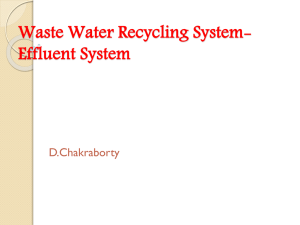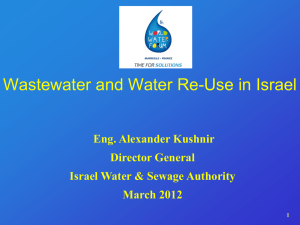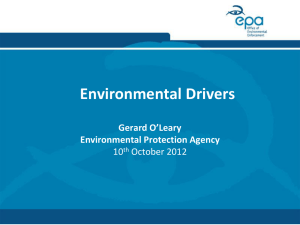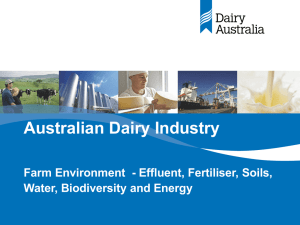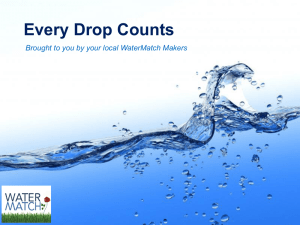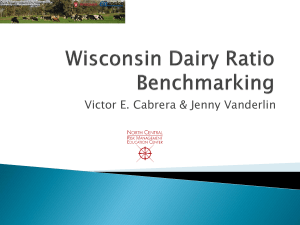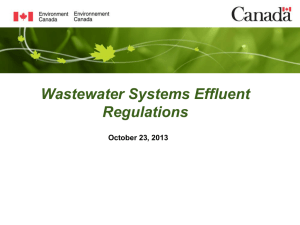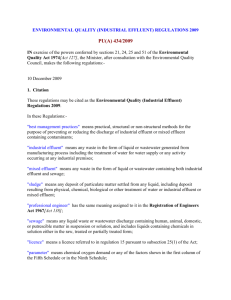Dairy Farming and Water Quality
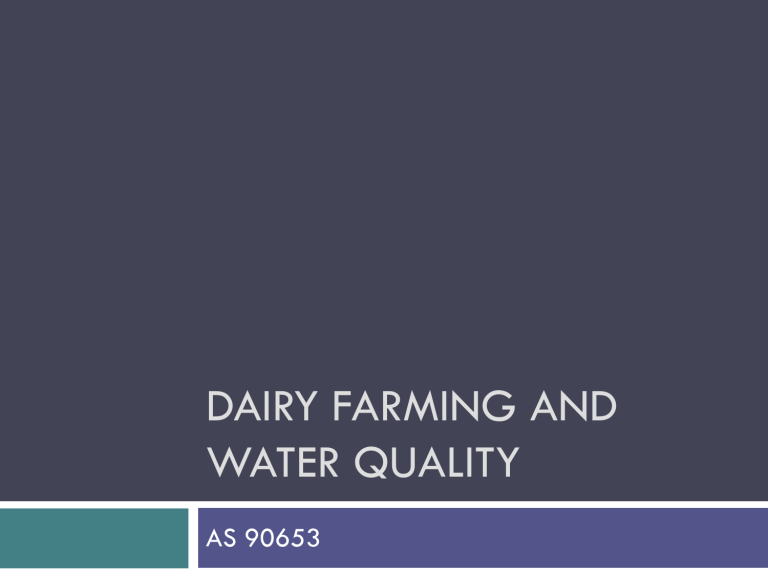
DAIRY FARMING AND
WATER QUALITY
AS 90653
Contents
Dairy farm contaminants and waterways
Effluent
Nutrients
Agrichemicals
Sediments
Dairy farm actions to mitigate
Riparian Planting
Effluent Management
Nutrient Management
Managing Waterways
Effluent
Poor effluent management can result in:
direct discharge into waterways indirect entry via surface runoff contamination of groundwater
Effluent can contain stormwater, spilled milk, soil and feed residue, detergents and other chemicals, in addition to the faeces, urine and washdown water.
Want to know more?
Best Practice
Management of
Dairy Farms being irrigated
Effluent
The organic matter in effluent requires oxygen to break it down.
This is measured in terms of its
Biological Oxygen Demand (BOD).
The oxygen needed to break down organic matter in effluent could otherwise be used by aquatic life. Therefore, effluent breakdown poses a threat to plant and animal life within a waterway.
Want to know more?
Best Practice
Management of
Dairy Farms being irrigated
Effluent
New Zealand's clean, green and unpolluted status is invaluable. It must be protected through farm management practices. World markets are becoming increasingly interested in the cleanliness of the farm dairy and the practices that are carried out there.
This info from Waikato Regional Council – see report managing farm dairy effluent
Want to know more?
Best Practice
Management of
Dairy Farms being irrigated
Effluent
The nutrients in effluent can cause excessive growth of bacterial and fungal slimes. These growths can change the quality of aquatic ecosystems, raise the pH of the water, and cause the death of sensitive animals and plants.
Want to know more?
Best Practice
Management of
Dairy Farms being irrigated
Effluent
Discharge of effluent into a waterway can pose a health threat to downstream users, since disease-causing microorganisms can be transmitted via water. Such micro-organisms make water unsafe for drinking or recreational use.
Want to know more?
Best Practice
Management of
Dairy Farms being irrigated
Effluent
Chemicals, such as pharmaceuticals and cleaning agents, can act as poisons to aquatic plants and animals
Want to know more?
Best Practice
Management of
Dairy Farms being irrigated
Effluent
The presence of effluent in New
Zealand’s waterways, and the effect that it has, can upset local residents and will give a poor impression to overseas visitors.
Farm dairy discharges compromise
Maori cultural and spiritual values
(kaitiakitanga). Direct discharges of treated or untreated effluent to waterways are culturally offensive to all New Zealanders.
Want to know more?
Best Practice
Management of
Dairy Farms being irrigated
Effluent
Where effluent enters marine environments it can have a negative impact on shellfish quality
Shellfish (such as mussels) are filter feeders and accumulate the microorganisms making them unsuitable for human consumption.
This info from NZ Landcare Trust (see fact sheet)
Want to know more?
Best Practice
Management of
Dairy Farms being irrigated
Effluent – summary of effects
Implications
Social • Recreational (swimming and trout fishing)
• Culturally offensive
Economic Increased costs of water treatment for downstream users
E-coli decreases aquaculture productivity (esp shellfish)
Wasted nutrients that could be utilised on farm
Implications for NZ clean green image affecting marketing of primary products and tourism.
Ecological Decreases oxygen content of water therefore impacting on aquatic biodiversity.
Nutrients within effluent contribute to aquatic plant and fungal slimes growth
Sediment
Sediment may alter the colour, clarity or temperature of a waterway. This can upset aquatic ecosystems as well as reduce the aesthetic value of the water.
Sediment will smother aquatic plants and may reduce light infiltration, adversely affecting plant photosynthesis.
Sediment can also smother insects on stream beds and clog up the gills of fish.
Sedimentation of waterways can raise the bed levels, causing flooding.
Sediments carry Phosphates (from fertilisers and manure) into waterways which feeds aquatic plant growth.
Nutrients
Ammonia-N is highly toxic to fish and aquatic animals, even at low concentrations (i.e. 0.2 to 1.0 g/m3 ).
Ammonia-N requires large quantities of oxygen to break it down. Therefore, ammonia breakdown depletes the oxygen levels of waterways.
Nutrients such as N and P increase aquatic plant growth, clogging waterways making water unpleasant for swimming and drinking.
Reducing stock losses
Bank errosion
Conserving soil
Improving stock health
Actions to Mitigate
